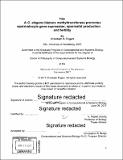A C. elegans histone methyltransferase promotes spermatocyte gene expression, spermatid production and fertility
Author(s)
Engert, Christoph G
DownloadFull printable version (9.227Mb)
Alternative title
Caenorhabditis elegans histone methyltransferase promotes spermatocyte gene expression, spermatid production and fertility
Other Contributors
Massachusetts Institute of Technology. Computational and Systems Biology Program.
Advisor
H. Robert Horvitz.
Terms of use
Metadata
Show full item recordAbstract
To better understand the tissue-specific regulation of chromatin state in cell-fate determination and development, we defined the tissue-specific expression of all 36 lysine methyltransferase (KMT) genes by endogenous mRNA detection in C. elegans. We found that most KMTs are expressed in only one or two tissues and that the germline is the tissue with the most general KMT expression. We discovered that the germline-expressed C. elegans ortholog of mammalian PRDM9, SET-1 7, promotes fertility through gene regulation in primary spermatocytes. SET-17 drives transcription of spermatocyte-specific genes from four genomic clusters to promote spermatid production. SET-1 7 is concentrated in stable, chromatin-associated nuclear foci at actively transcribed gene clusters, which we term spermatocyte transcription bodies. Our results identify the spatially restricted function of a PRDM9 ortholog in spermatocyte transcription and we propose that the spatial organization of chromatin factors might be a conserved mechanism in tissue-specific control of transcription.
Description
Thesis: Ph. D., Massachusetts Institute of Technology, Computational and Systems Biology Program, 2017. Cataloged from PDF version of thesis. Includes bibliographical references.
Date issued
2017Department
Massachusetts Institute of Technology. Computational and Systems Biology ProgramPublisher
Massachusetts Institute of Technology
Keywords
Computational and Systems Biology Program.